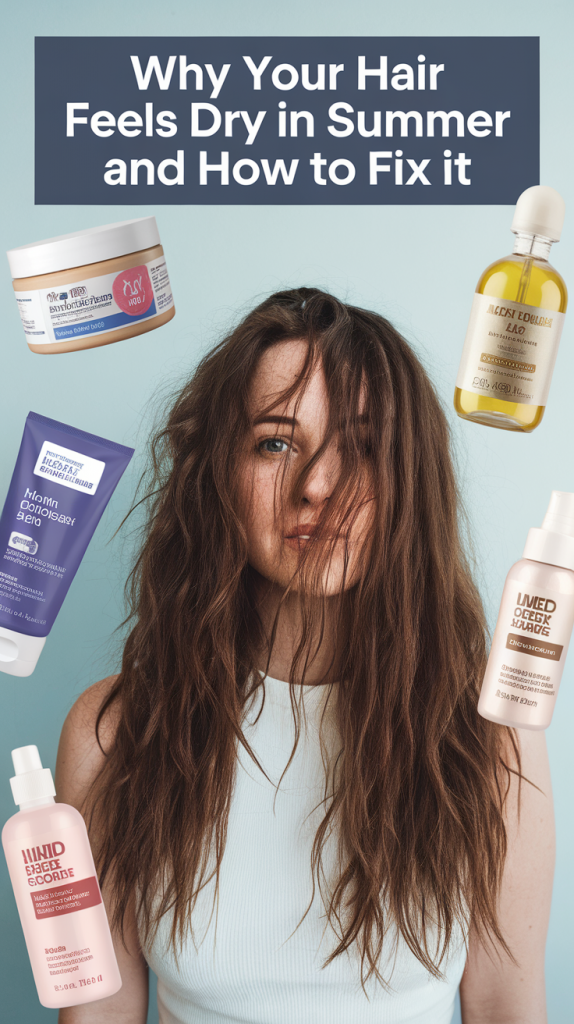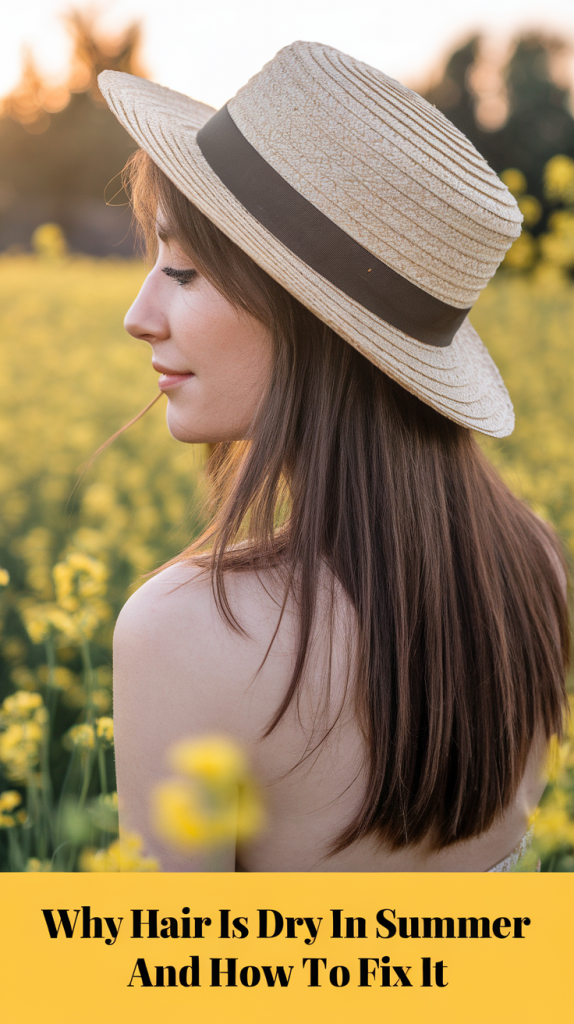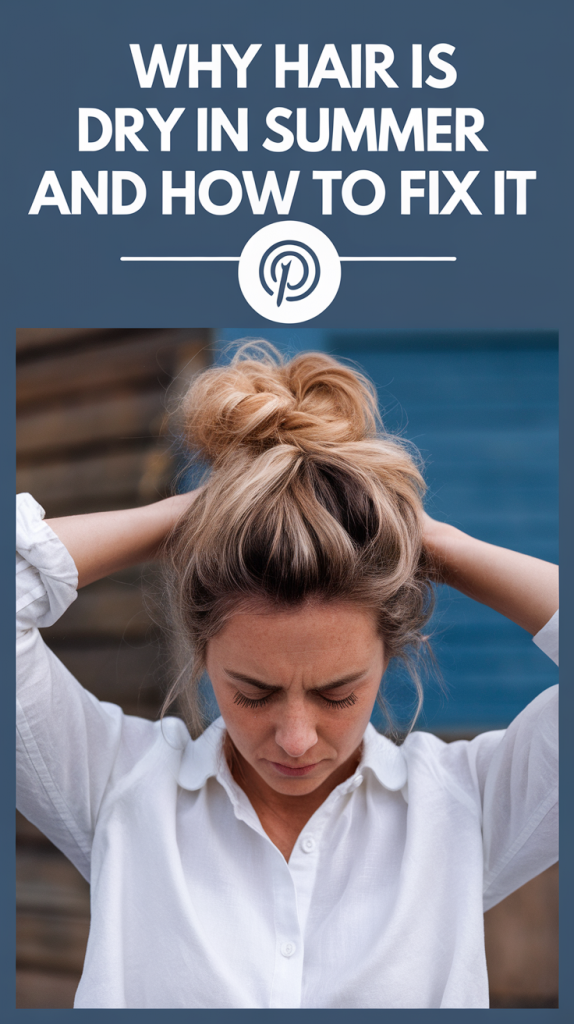Why Your Hair Feels Dry in Summer and How to Fix It Fast in 2025 – Expert Guide
The dry summer causes hair dryness, which affects 68 percent of American women. Heat in Arizona and Florida has made summer into a season that removes moisture from hair for most people who live there. However, there is good news! Science supports several easy methods for defending your hair along with restoring its natural shine.
The following guide explains the summer-related factors that cause dry hair while identifying daily behaviors that contribute to the problem and presents immediate solution methods. This article explores the complete picture of UV damage and chlorinated pools together with dehydration while investigating problems created by wrong products.
Which individuals will benefit from this piece?
People who live in hot climates, along with ocean and pool swimmers and daily hairstylists, should read this article.

Why Hair Gets So Dry in the Summer-Main Causes in 2025
UV Radiation Is the #1 Culprit
Just like your skin, the sun can also negatively impact your hair. The sun emits ultraviolet (UV) rays, which can damage the hair shaft by splitting the cuticle, leading to moisture loss, coarse texture, and even color loss. Think of what happens when you forget a lovely silk blouse you own in the sun for a few days. Now imagine doing that every day for 3 months.
For those residing in Southern California or Texas, where UV indexes are high in summer, this is very true. It also holds true for people living in regions with milder climates, as prolonged time outdoors can stealthily damage your hair.
The following is a list of the most common symptoms of UV damage to hair.
- Split slow ends
- Less shiny hair
- Increased difficulty in detangling hair
- Dull or tinted blonde hair
Dr. Melanie King who practices as a trichologist in Miami states that dry hair after ocean exposure actually exists beyond your perception.
Chlorine, Salt Water, and Hard Water Damage
Salty ocean waves and chlorinated pools are summer essentials, but they also deplete your strands’ natural oils. Chlorine, for example, attaches to the hair’s protein, making it breakable and porous. As for salt, it also leads to dehydration, which roughens up and weakens the strands.
Approximately 85% of American households struggle with hard water. It is high in calcium and magnesium and forms mineral residue that prevents hydration from penetrating the hair shaft.
States that are most affected include
- Southern California
- Nevada
- Arizona
- Indiana
If you live in these areas and wash your hair on a regular basis, then that’s a double whammy for you.
Air Conditioning and Dehydration
Warm summer temperatures save your life by giving you inside relief while simultaneously harming your hair quality. When AC units reduce indoor humidity levels, people experience an environment that becomes dry enough to cause damage to their scalp and hair.
The summer heat makes your body lose additional water while you expose your scalp to dry, chilled air. People who do not hydrate sufficiently may face problems with their hair follicles because they lack sufficient moisture. The dryness suffered within your body creates noticeable effects on your hair.
The temperature inside air-conditioned spaces produces flyaways as well as frizz while you sit exposed to them throughout the day. You’re not alone. Summer dryness operates as a secret cause that damages the scalp and hair condition.
How to Prevent and Reverse Summer Hair Dryness: Step-by-Step Guide
Switch to Summer-Safe Hair Products
The initial step is to modify your hair care routine for the season as you would when swapping from boots to sandals.
Look for those shampoos and conditioners that are marked as Deeply Hydrating, UV Protective and sulfate free. Stay clear of high alcohol content products and strong cleansers that remove natural oils.
And here is a simple chart of reliable products that can be found in the United States.
| Product Name | Type | Where to Buy | Key Benefit |
|---|---|---|---|
| Olaplex 6 | Leave-in cream | Sephora | Restores moisture, strengthens ends |
| Aveda Sun Veil | UV spray | Ulta | UV protection with botanicals |
| SheaMoisture Hydrate | Mask | Target | Ideal for curly or dry hair types |
✅ Tip: Use a clarifying shampoo once every two weeks to remove mineral or chlorine buildup.

Home Remedies That Actually Work
Correct, kitchen-based care is still useful in the year 2025; that is, if you know what ingredients to incorporate.
Here’s a simple recipe for a DIY Hydration Mask:
- ½ ripe avocado
- 2 tablespoons aloe vera gel
- 1 tablespoon honey
Massage the blend on damp hair and let it sit for 30 minutes. Rinse off with cool water.
Natural oils such as argan, coconut, and jojoba can help restore moisture without weighing hair down. Rub some drops between your palms and distribute them through your mid-lengths and ends.
📌 Don’t overdo it. Without proper washing, excess oils can dull the shine of your hair.
Adjust Your Summer Hair Routine
Every day of the week, if you are still shampooing, I would like you to take a break. Overwashing removes your hair’s natural protective shield. The problem becomes worse during the summer when extreme dryness sets in quickly.
✅ Summer Practices Endorsed By Experts:
- Shampoo your hair no more than twice a week
- Use a rinse out conditioner every time you shampoo
- Use a leave in conditioner or a heat protectant if you are styling your hair
NYC stylist Gina Lopez recommends that conditioner serves as your summertime best friend when it comes to protecting your hair. The butter protects your cuticles and stops water from escaping your hair.
Summer-Proof Hair Habits for Everyday Life
Protective Hairstyles and Accessories
Correct product usage is only one facet in maintaining your hair; mechanically protecting your hair is just as important.
Wearing your hair in braids, low buns, or twists will shield your hair from the harmful rays of the sun and pollution. Use silk scrunchies, as they provide a gentler hold and less breakage.
The following are examples of hair accessories that will be popular in 2025:
- Silk scarves (especially if the hair is color treated)
- Baseball caps made out of UV blocking fabric
- Wide brimmed straw hats with SPF linings
Wearing your hair out when the temperature reaches beyond 100 °F (around 38°C) is not advisable.

Diet, Hydration, and Hair Supplements
Without body hydration, you cannot moisturize your hair.
If you are very active or spend a lot of time outside, especially in the summer, make sure to drink no less than 2.5 liters every day.
Some foods that promote healthy hair are:
- Spinach and kale—high in folate and iron
- Berries and citrus fruits- rich in vitamin C
- Omega-3s and zinc for scalp health can be obtained from nuts and seeds
Yes, biotin still helps, but nowadays it is better when combined with collagen satirically speaking or vitamin D3 as part of formulas being made for 2025.
Common Mistakes That Make Hair Dryer in Summer
Now let’s shift focus to what *not* to do. Even the most effective haircare regimen cannot mitigate these summer haircare disasters:
- Rinsing hair with hot water
- Forgoing conditioner and mask treatments
- Using gels or sprays with alcohol content
- Failing to shield hair from the pool and ocean
- Daily application of heat styling tools without thermal guards
📌 There is a quicker solution:
Make it a point to eliminate cool rinses and replace them with lukewarm rinses. This way, the moisture is retained better.
Let me ask you this:
How many times do you pick up the straightener during July without any prior thought?
Latest Research and Innovations in Hair Protection (2025)
The beauty technology sector is set to explode in 2025, with hair care close in pursuit.
Innovative breakthroughs capturing attention include
- Hair clips that can monitor your exposure and notify you once it becomes too high.
- Smart leave-in products that alter hydration levels based on the humidity of their environment.
- Serums with Protein Nanocomplexes to reinforce and repair the damaged hair fibers.
Dermatologists now recommend off-season scalp scans available at most hair salons in LA, NYC, and Chicago to monitor moisture levels and product efficacy.
For tech enthusiasts, consider checking out the apps that interface with the smart brushes to evaluate your brushing and offer tailored care recommendations.
What to Do If Your Hair Already Feels Extremely Dry
There’s still hope left. If your hair currently feels as if it’s made of straw, follow these steps for immediate assistance:
Restoration of moisture: Step-by-step
- Begin with a deep cleanse using a clarifying shampoo.
- Apply protein-intensive treatment for 15 to 20 minutes
- Rinse it off, then use a hydrating conditioner.
- Finish off with leave-in oil or cream.
- Use a silk wrap at night to retain moisture overnight.
If done weekly for three to four weeks, you will begin to notice the bounce returning.
Conclusion: Your Summer Hair Survival Kit
We should look back at what we have learned.
- The summer dryness is true and it comes about when there is too much sun, salt water, chlorinated water and air conditioned rooms or by dehydration from within
- Prevent damage with SPF hair products the right hairstyles and adequate hydration.
- Do-it-yourself masks, as well as new inventions, all have a role to play in your routines in 2025.
- Tiny daily habits matter a lot for the health of your hair
💬 What works for your summer hair care? Are you into coconut oil or Olaplex? Please leave your thoughts, tips or questions below

